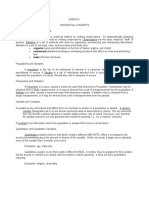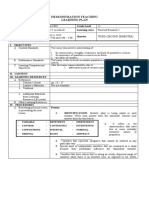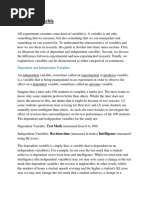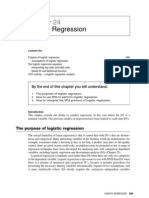Classification of Variables
Uploaded by
Ella LopezClassification of Variables
Uploaded by
Ella Lopez📄
Lesson 3: Classification of
Variables
In any research, we deal with factors or properties in order to study something. This
factor or property that we measure, control, or manipulate in quantitative research is
called a variable.
Variables can be classified into different types depending on context.
Numeric – variables with values describing a number or quantity that can be measured
and answers the questions “how many” or “how much”
Discrete – variables that are countable in a fixed amount of time and can only
assume any whole value within the limits of the given variables.
Examples: Population of students, money in your wallet, number of family
members, number of business locations
Continuous – variables that take an infinite amount of time to be counted and can
assume any value between a certain set of real numbers.
Examples: Age, height, weight, temperature, time
Categorical – variables with values describing a characteristic or quality which answers
the questions “what type” or “which category”
Lesson 3: Classification of Variables 1
Nominal – variables whose values cannot be organized in sequence or logical
manner
Examples: Eye color, languages spoken, business types
Ordinal – variables that can take a value that can be logically arranged in a
sequence or rank
Examples: Academic grades (A, B, C, F), clothing size (S, M, L, XL), measure
of attitudes (strongly agree, agree, disagree, strongly disagree)
Dichotomous – variables that represent two categories
Examples: True or false, yes or no
Experimental
Independent – variable manipulated in an experiment and causes the change/s to
the other variable/s in the study; also known as manipulated or explanatory variable
Dependent – variable affected by the manipulation of the independent variable;
also known as response or predicted variable
Extraneous – variables already existing in the experiment that could affect the
results of the study; also known as mediating, intervening, or covariate variable
Example: Use of Gardening Tools and Types of Fertilizer: Their Effects on the Amount
of Harvest
Independent: Use of gardening tools, types of fertilizer
Dependent: Amount of harvest
Extraneous: Humidity level, types of plants
Non-experimental
Predictor – variables that change the other variables in the study
Criterion – variables are usually influenced by the predictor variable
Example: Conduct of Guidance Counseling Programs to the Degree of Absenteeism
and Drop-Out Rate among Grade 8 Classes
Predictor: Conduct of guidance counseling programs
Criterion: degree of absenteeism, drop-out rate
Lesson 3: Classification of Variables 2
Lesson 3: Classification of Variables 3
You might also like
- Solution Manual For Introduction To Statistical Investigations 1st Edition by Tintle PDF0% (1)Solution Manual For Introduction To Statistical Investigations 1st Edition by Tintle PDF3 pages
- Variables in Quantitative Research: Mrs. Catherine Calixto-Valera100% (1)Variables in Quantitative Research: Mrs. Catherine Calixto-Valera12 pages
- Las3 q1 Pr2 September 24 2021 Submission DateNo ratings yetLas3 q1 Pr2 September 24 2021 Submission Date8 pages
- Target: Before Proceeding Further, Check How Much You Know About BusinessNo ratings yetTarget: Before Proceeding Further, Check How Much You Know About Business16 pages
- Practical Research 2: Quarter 1 - Module 3 VariablesNo ratings yetPractical Research 2: Quarter 1 - Module 3 Variables11 pages
- Lesson 3 Variables in Quantitative ResearchNo ratings yetLesson 3 Variables in Quantitative Research2 pages
- Tel./Fax No. (047) 602 1391 E-Mail Address: Zambales@deped - Gov.ph Website: WWW - Depedzambales.phNo ratings yetTel./Fax No. (047) 602 1391 E-Mail Address: Zambales@deped - Gov.ph Website: WWW - Depedzambales.ph15 pages
- Stat - Lesson 1 Concepts and DefinitionsNo ratings yetStat - Lesson 1 Concepts and Definitions5 pages
- Senior High School Department: Caldwell Adventist AcademyNo ratings yetSenior High School Department: Caldwell Adventist Academy4 pages
- Shs12 Pracresearch2 q1 SLM Mod Differentiates The Kinds of Variables and Their UsesNo ratings yetShs12 Pracresearch2 q1 SLM Mod Differentiates The Kinds of Variables and Their Uses18 pages
- Activity Sheet Week 3 Variables - ZAPATANo ratings yetActivity Sheet Week 3 Variables - ZAPATA3 pages
- St. Mary's Educational Institute: Online Learning 1No ratings yetSt. Mary's Educational Institute: Online Learning 110 pages
- Questionnaire Construction and AdministrationNo ratings yetQuestionnaire Construction and Administration6 pages
- PredictingTitanicSurvivorsusing by Applying Exploratory Data Anyltics and MLNo ratings yetPredictingTitanicSurvivorsusing by Applying Exploratory Data Anyltics and ML7 pages
- Statistical Analysis with Software Application100% (1)Statistical Analysis with Software Application6 pages
- Solutions for Intro Stats 6th Edition by De VeauxNo ratings yetSolutions for Intro Stats 6th Edition by De Veaux21 pages
- Structural Equation Modeling with Mplus Basic Concepts Applications and Programming 1st Edition Barbara M. Byrne all chapter instant download100% (5)Structural Equation Modeling with Mplus Basic Concepts Applications and Programming 1st Edition Barbara M. Byrne all chapter instant download50 pages
- Mathematics in The Modern World Module Week 1 2No ratings yetMathematics in The Modern World Module Week 1 230 pages
- Playit: Game Based Learning Approach For Teaching Programming ConceptsNo ratings yetPlayit: Game Based Learning Approach For Teaching Programming Concepts14 pages
- Classification Basedon Decision Tree AlgorithmNo ratings yetClassification Basedon Decision Tree Algorithm10 pages
- Predictive Modelling For Customer's Credit Worthiness: 1. Data Exploration InsightsNo ratings yetPredictive Modelling For Customer's Credit Worthiness: 1. Data Exploration Insights3 pages
- 商業統計bbs14ege ch02 Organizing and Visualizing VariablesNo ratings yet商業統計bbs14ege ch02 Organizing and Visualizing Variables85 pages
























































































